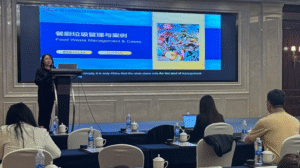Shaoxing, Zhejiang – 16 May 2025 – Zhejiang Zhongzheng Forestry Development Co., Ltd. took centre stage at the Asian Development Bank’s “Training on Circular Economy and Sustainable Solid Waste Management” workshop in Shaoxing, with General Manager Huang Hexiong delivering a keynote address on the critical role of forest carbon sinks in achieving China’s “dual-carbon” targets of peaking emissions before 2030 and reaching carbon neutrality by 2060.
In his speech, Huang underlined the irreplaceable value of forests as the world’s largest terrestrial carbon reservoirs. By advancing afforestation, forest management, and grassland restoration, he argued, carbon sinks not only combat climate change but also unlock dual ecological and economic benefits. “Developing forest carbon sink projects is not simply an environmental imperative—it is a pathway to sustainable growth,” Huang said.
Proven Impact Through Flagship Projects
Since its establishment in 2011, Zhejiang Zhongzheng has become a leader in carbon sink project development, carbon asset management, and carbon neutrality services, deploying both international standards such as the Verified Carbon Standard (VCS) and China’s Certified Emission Reduction (CCER) scheme.
Among its landmark initiatives are:
- Hubei Hongshan Forest Management Project : Covering 23,000 hectares, projected to cut 6.8 million tonnes of emissions over 30 years. The first issuance of 930,000 tonnes of credits was fully sold, setting a national record for single carbon credit transactions.
- Fujian Pucheng and Henan Luoning Projects : Delivering annual reductions of 80,000 and 100,000 tonnes.
- Gansu Tianzhu and Diba Grassland Projects : Covering 120,000 hectares with annual reductions exceeding 320,000 tonnes.
- Mongolia Nationwide Carbon Sink Programme : Offering potential reductions of 370 million tonnes, with 9.25 million tonnes annually.
China’s voluntary CCER afforestation projects in Henan and Tibet are also underway, positioning the company at the forefront of the national market’s relaunch.
Driving Policy and Market Synergies
Huang’s address also explored China’s evolving policy landscape, including the Regulations on Carbon Emission Trading (Trial) and the expansion of carbon markets to industries such as power, steel, aviation, and construction materials. He noted the implications of the EU’s Carbon Border Adjustment Mechanism (CBAM), which is reshaping export dynamics and accelerating corporate demand for carbon asset management.
Economic Potential of Carbon Sinks
Highlighting the financial promise of forestry projects, Huang illustrated that developing 1 million acre (about 66,700 hectares) of forestland could generate CNY 30 million annually, or CNY 900 million over 30 years, assuming a carbon price of CNY 100 per tonne. “Carbon sinks can deliver sustainable green income for governments and landowners, while contributing to global climate governance,” he added.

A Call for Global Cooperation
Concluding his speech, Huang urged the governments, businesses, and international organisations to strengthen their mutual collaboration and accelerate the standardisation and scaling of forest carbon sink projects. “By transforming ecological strengths into economic drivers, we can offer practical green solutions to global climate challenges,” he stated.
The presentation, rich in case studies and data, received strong recognition from participants, underscoring the leadership of Chinese enterprises in advancing innovative, internationally credible carbon sink solutions. Zhejiang Zhongzheng Forestry Development Co., Ltd. reaffirmed its commitment to working with global partners to co-create a sustainable, low-carbon future.




